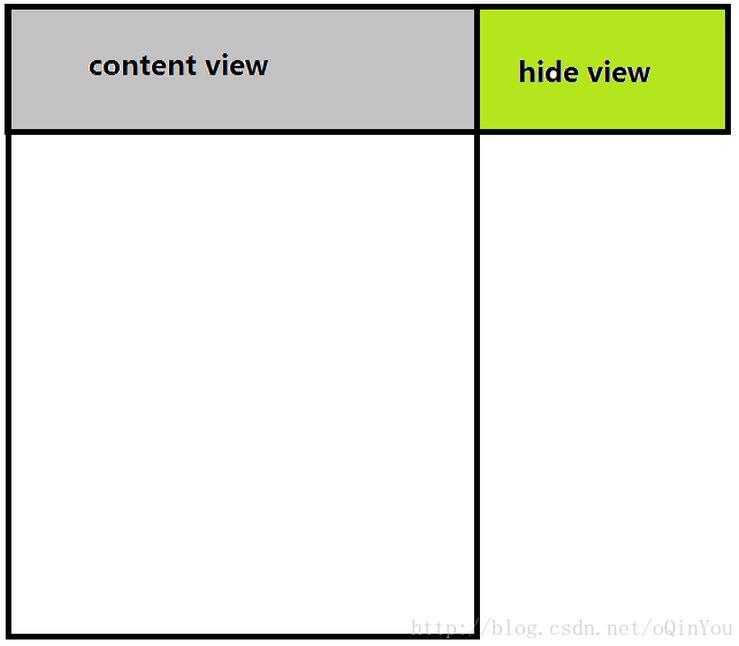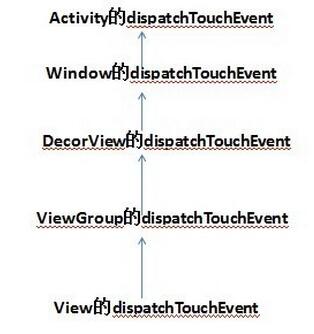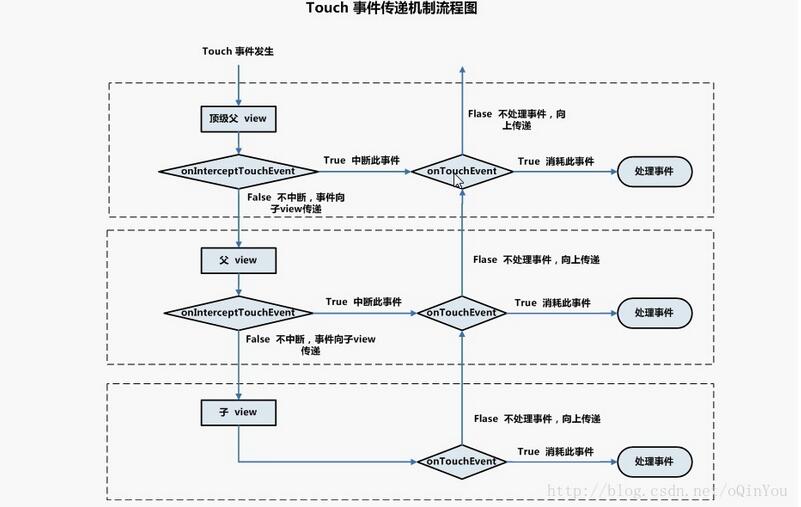您好,登录后才能下订单哦!
怎么在Android应用中实现一个抽屉效果?很多新手对此不是很清楚,为了帮助大家解决这个难题,下面小编将为大家详细讲解,有这方面需求的人可以来学习下,希望你能有所收获。
实现原理
其实单就一个SwipeLayout的实现原理来讲的话,还是很简单的,实际上单个SwipeLayout隐藏抽屉状态时,应该是这样的:

也就是说,最初的隐藏状态,实际上是将hide view区域layout到conten view的右边,达到隐藏效果,而后显示则是根据拖拽的x值变化来动态的layout 2个view,从而达到一个滑动抽屉效果。
当然,直接重写view的onTouchEvent来动态的layout 2个view是可以实现我们需要的效果的,但是有更好的方法来实现,就是同过ViewDragHelper。
ViewDragHelper是google官方提供的一个专门用于手势分析处理的类,关于ViewDragHelper的基本使用,网上有一大堆的资源。具体的ViewDragHelper介绍以及基本使用方法,本文就不重复造轮子了,此处推荐鸿洋大神的一篇微博:Android ViewDragHelper完全解析 自定义ViewGroup神器。
具体实现
下面我们开始具体的实现。
布局比较简单,这里就不贴代码了,最后会贴上本demo的完整代码地址。
首先我们实现一个继承FrameLayout的自定义SwipeLauout,重写onFinishInflate方法:
这里我们只允许SwipeLayout设置2个子View,ContentLayout是继承LinearLayout的自定义layout,后面会讲到这个,此处先略过;
@Override
protected void onFinishInflate() {
super.onFinishInflate();
if (getChildCount() != 2) {
throw new IllegalStateException("Must 2 views in SwipeLayout");
}
contentView = getChildAt(0);
hideView = getChildAt(1);
if (contentView instanceof ContentLayout)
((ContentLayout) contentView).setSwipeLayout(this);
else {
throw new IllegalStateException("content view must be an instanceof FrontLayout");
}
}接着重写onSizeChanged,onLayout,onInterceptTouchEvent方法:
@Override
protected void onSizeChanged(int w, int h, int oldw, int oldh) {
super.onSizeChanged(w, h, oldw, oldh);
hideViewHeight = hideView.getMeasuredHeight();
hideViewWidth = hideView.getMeasuredWidth();
contentWidth = contentView.getMeasuredWidth();
}
@Override
protected void onLayout(boolean changed, int left, int top, int right,
int bottom) {
// super.onLayout(changed, left, top, right, bottom);
contentView.layout(0, 0, contentWidth, hideViewHeight);
hideView.layout(contentView.getRight(), 0, contentView.getRight()
+ hideViewWidth, hideViewHeight);
}
@Override
public boolean onInterceptTouchEvent(MotionEvent ev) {
boolean result = viewDragHelper.shouldInterceptTouchEvent(ev);
// Log.e("SwipeLayout", "-----onInterceptTouchEvent-----");
return result;
}然后是比较关键的,重写onTouchEvent方法以及ViewDragHelper.Callback回调,我们定了一个enum来判断SwipeLayout的三种状态。在onViewPositionChanged中,有2种方法实现content view和hide view的伴随移动,一种是直接offset view的横向变化量,还有一种就是直接通过layout的方式,两种方式都可以。
public enum SwipeState {
Open, Swiping, Close;
}
@Override
public boolean onTouchEvent(MotionEvent event) {
// Log.e("SwipeLayout", "-----onTouchEvent-----");
switch (event.getAction()) {
case MotionEvent.ACTION_DOWN:
downX = event.getX();
downY = event.getY();
break;
case MotionEvent.ACTION_MOVE:
// 1.获取x和y方向移动的距离
float moveX = event.getX();
float moveY = event.getY();
float delatX = moveX - downX;// x方向移动的距离
float delatY = moveY - downY;// y方向移动的距离
if (Math.abs(delatX) > Math.abs(delatY)) {
// 表示移动是偏向于水平方向,那么应该SwipeLayout应该处理,请求listview不要拦截
this.requestDisallowInterceptTouchEvent(true);
}
// 更新downX,downY
downX = moveX;
downY = moveY;
break;
case MotionEvent.ACTION_UP:
break;
}
viewDragHelper.processTouchEvent(event);
return true;
}
private ViewDragHelper.Callback callback = new ViewDragHelper.Callback() {
@Override
public boolean tryCaptureView(View child, int pointerId) {
return child == contentView || child == hideView;
}
@Override
public int getViewHorizontalDragRange(View child) {
return hideViewWidth;
}
@Override
public int clampViewPositionHorizontal(View child, int left, int dx) {
if (child == contentView) {
if (left > 0)
left = 0;
if (left < -hideViewWidth)
left = -hideViewWidth;
} else if (child == hideView) {
if (left > contentWidth)
left = contentWidth;
if (left < (contentWidth - hideViewWidth))
left = contentWidth - hideViewWidth;
}
return left;
}
@Override
public void onViewPositionChanged(View changedView, int left, int top,
int dx, int dy) {
super.onViewPositionChanged(changedView, left, top, dx, dy);
if (changedView == contentView) {
// 如果手指滑动deleteView,那么也要讲横向变化量dx设置给contentView
hideView.offsetLeftAndRight(dx);
} else if (changedView == hideView) {
// 如果手指滑动contentView,那么也要讲横向变化量dx设置给deleteView
contentView.offsetLeftAndRight(dx);
}
// if (changedView == contentView) {
// // 手动移动deleteView
// hideView.layout(hideView.getLeft() + dx,
// hideView.getTop() + dy, hideView.getRight() + dx,
// hideView.getBottom() + dy);
// } else if (hideView == changedView) {
// // 手动移动contentView
// contentView.layout(contentView.getLeft() + dx,
// contentView.getTop() + dy, contentView.getRight() + dx,
// contentView.getBottom() + dy);
// }
//实时更新当前状态
updateSwipeStates();
invalidate();
}
@Override
public void onViewReleased(View releasedChild, float xvel, float yvel) {
super.onViewReleased(releasedChild, xvel, yvel);
//根据用户滑动速度处理开关
//xvel: x方向滑动速度
//yvel: y方向滑动速度
// Log.e("tag", "currentState = " + currentState);
// Log.e("tag", "xvel = " + xvel);
if (xvel < -200 && currentState != SwipeState.Open) {
open();
return;
} else if (xvel > 200 && currentState != SwipeState.Close) {
close();
return;
}
if (contentView.getLeft() < -hideViewWidth / 2) {
// 打开
open();
} else {
// 关闭
close();
}
}
};open(),close()实现
public void open() {
open(true);
}
public void close() {
close(true);
}
/**
* 打开的方法
*
* @param isSmooth 是否通过缓冲动画的形式设定view的位置
*/
public void open(boolean isSmooth) {
if (isSmooth) {
viewDragHelper.smoothSlideViewTo(contentView, -hideViewWidth,
contentView.getTop());
ViewCompat.postInvalidateOnAnimation(SwipeLayout.this);
} else {
contentView.offsetLeftAndRight(-hideViewWidth);//直接偏移View的位置
hideView.offsetLeftAndRight(-hideViewWidth);//直接偏移View的位置
// contentView.layout(-hideViewWidth, 0, contentWidth - hideViewWidth, hideViewHeight);//直接通过坐标摆放
// hideView.layout(contentView.getRight(), 0, hideViewWidth, hideViewHeight);//直接通过坐标摆放
invalidate();
}
}
/**
* 关闭的方法
*
* @param isSmooth true:通过缓冲动画的形式设定view的位置
* false:直接设定view的位置
*/
public void close(boolean isSmooth) {
if (isSmooth) {
viewDragHelper.smoothSlideViewTo(contentView, 0, contentView.getTop());
ViewCompat.postInvalidateOnAnimation(SwipeLayout.this);
} else {
contentView.offsetLeftAndRight(hideViewWidth);
hideView.offsetLeftAndRight(hideViewWidth);
invalidate();
//contentView.layout(0, 0, contentWidth, hideViewHeight);//直接通过坐标摆放
//hideView.layout(contentView.getRight(), 0, hideViewWidth, hideViewHeight);//直接通过坐标摆放
}
}此上基本实现了单个SwipeLayout的抽屉滑动效果,但是将此SwipeLayout作为一个item布局设置给一个listView的时候,还需要做许多的判断。
由于listView的重用机制,我们这里并未针对listview做任何处理,所以一旦有一个item的SwipeLayout的状态是打开状态,不可避免的其它也必然有几个是打开状态,所以我们这里需要根据检测listView的滑动,当listView滑动时,关闭SwipeLayout。既然需要在外部控制SwipeLayout的开关,我们先定义一个SwipeLayoutManager用于管理SwipeLayout的控制。
public class SwipeLayoutManager {
//记录打开的SwipeLayout集合
private HashSet<SwipeLayout> mUnClosedSwipeLayouts = new HashSet<SwipeLayout>();
private SwipeLayoutManager() {
}
private static SwipeLayoutManager mInstance = new SwipeLayoutManager();
public static SwipeLayoutManager getInstance() {
return mInstance;
}
/**
* 将一个没有关闭的SwipeLayout加入集合
* @param layout
*/
public void add(SwipeLayout layout) {
mUnClosedSwipeLayouts.add(layout);
}
/**
* 将一个没有关闭的SwipeLayout移出集合
* @param layout
*/
public void remove(SwipeLayout layout){
mUnClosedSwipeLayouts.remove(layout);
}
/**
* 关闭已经打开的SwipeLayout
*/
public void closeUnCloseSwipeLayout() {
if(mUnClosedSwipeLayouts.size() == 0){
return;
}
for(SwipeLayout l : mUnClosedSwipeLayouts){
l.close(true);
}
mUnClosedSwipeLayouts.clear();
}
/**
* 关闭已经打开的SwipeLayout
*/
public void closeUnCloseSwipeLayout(boolean isSmooth) {
if(mUnClosedSwipeLayouts.size() == 0){
return;
}
for(SwipeLayout l : mUnClosedSwipeLayouts){
l.close(isSmooth);
}
mUnClosedSwipeLayouts.clear();
}
}这样就可以监听listView的滑动,然后在listView滑动的时候,关闭所有的抽屉View。
listView.setOnScrollListener(new OnScrollListener() {
@Override
public void onScrollStateChanged(AbsListView view, int scrollState) {
swipeLayoutManager.closeUnCloseSwipeLayout();
}
@Override
public void onScroll(AbsListView view, int firstVisibleItem, int visibleItemCount, int totalItemCount) {
}
});考虑到大多数时候,在我们打开抽屉View和关闭抽屉View的时候,外部需要知道SwipeLayout的状态值,所以我们需要在SwipeLayout中增加几个接口,告诉外部当前SwipeLayout的状态值:
SwipeLayout.java
----------------
private void updateSwipeStates() {
SwipeState lastSwipeState = currentState;
SwipeState swipeState = getCurrentState();
if (listener == null) {
try {
throw new Exception("please setOnSwipeStateChangeListener first!");
} catch (Exception e) {
e.printStackTrace();
}
return;
}
if (swipeState != currentState) {
currentState = swipeState;
if (currentState == SwipeState.Open) {
listener.onOpen(this);
// 当前的Swipelayout已经打开,需要让Manager记录
swipeLayoutManager.add(this);
} else if (currentState == SwipeState.Close) {
listener.onClose(this);
// 说明当前的SwipeLayout已经关闭,需要让Manager移除
swipeLayoutManager.remove(this);
} else if (currentState == SwipeState.Swiping) {
if (lastSwipeState == SwipeState.Open) {
listener.onStartClose(this);
} else if (lastSwipeState == SwipeState.Close) {
listener.onStartOpen(this);
//hideView准备显示之前,先将之前打开的的SwipeLayout全部关闭
swipeLayoutManager.closeUnCloseSwipeLayout();
swipeLayoutManager.add(this);
}
}
} else {
currentState = swipeState;
}
}
/**
* 获取当前控件状态
*
* @return
*/
public SwipeState getCurrentState() {
int left = contentView.getLeft();
// Log.e("tag", "contentView.getLeft() = " + left);
// Log.e("tag", "hideViewWidth = " + hideViewWidth);
if (left == 0) {
return SwipeState.Close;
}
if (left == -hideViewWidth) {
return SwipeState.Open;
}
return SwipeState.Swiping;
}
private OnSwipeStateChangeListener listener;
public void setOnSwipeStateChangeListener(
OnSwipeStateChangeListener listener) {
this.listener = listener;
}
public View getContentView() {
return contentView;
}
public interface OnSwipeStateChangeListener {
void onOpen(SwipeLayout swipeLayout);
void onClose(SwipeLayout swipeLayout);
void onStartOpen(SwipeLayout swipeLayout);
void onStartClose(SwipeLayout swipeLayout);
}然后接下来是写一个为listView设置的SwipeAdapter
SwipeAdapter.java
------------
public class SwipeAdapter extends BaseAdapter implements OnSwipeStateChangeListener {
private Context mContext;
private List<String> list;
private MyClickListener myClickListener;
private SwipeLayoutManager swipeLayoutManager;
public SwipeAdapter(Context mContext) {
super();
this.mContext = mContext;
init();
}
private void init() {
myClickListener = new MyClickListener();
swipeLayoutManager = SwipeLayoutManager.getInstance();
}
public void setList(List<String> list){
this.list = list;
notifyDataSetChanged();
}
@Override
public int getCount() {
return list.size();
}
@Override
public Object getItem(int position) {
return list.get(position);
}
@Override
public long getItemId(int position) {
return position;
}
@Override
public View getView(final int position, View convertView, ViewGroup parent) {
if (convertView == null) {
convertView = UIUtils.inflate(R.layout.list_item_swipe);
}
ViewHolder holder = ViewHolder.getHolder(convertView);
holder.tv_content.setText(list.get(position));
holder.tv_overhead.setOnClickListener(myClickListener);
holder.tv_overhead.setTag(position);
holder.tv_delete.setOnClickListener(myClickListener);
holder.tv_delete.setTag(position);
holder.sv_layout.setOnSwipeStateChangeListener(this);
holder.sv_layout.setTag(position);
holder.sv_layout.getContentView().setOnClickListener(new View.OnClickListener() {
@Override
public void onClick(View v) {
ToastUtils.showToast("item click : " + position);
swipeLayoutManager.closeUnCloseSwipeLayout();
}
});
return convertView;
}
static class ViewHolder {
TextView tv_content, tv_overhead, tv_delete;
SwipeLayout sv_layout;
public ViewHolder(View convertView) {
tv_content = (TextView) convertView.findViewById(R.id.tv_content);
tv_overhead = (TextView) convertView.findViewById(R.id.tv_overhead);
tv_delete = (TextView) convertView.findViewById(R.id.tv_delete);
sv_layout = (SwipeLayout) convertView.findViewById(R.id.sv_layout);
}
public static ViewHolder getHolder(View convertView) {
ViewHolder holder = (ViewHolder) convertView.getTag();
if (holder == null) {
holder = new ViewHolder(convertView);
convertView.setTag(holder);
}
return holder;
}
}
class MyClickListener implements View.OnClickListener {
@Override
public void onClick(View v) {
Integer position = (Integer) v.getTag();
switch (v.getId()) {
case R.id.tv_overhead:
//ToastUtils.showToast("position : " + position + " overhead is clicked.");
}
break;
case R.id.tv_delete:
//ToastUtils.showToast("position : " + position + " delete is clicked.");
}
break;
default:
break;
}
}
}
@Override
public void onOpen(SwipeLayout swipeLayout) {
//ToastUtils.showToast(swipeLayout.getTag() + "onOpen.");
}
@Override
public void onClose(SwipeLayout swipeLayout) {
//ToastUtils.showToast(swipeLayout.getTag() + "onClose.");
}
@Override
public void onStartOpen(SwipeLayout swipeLayout) {
// ToastUtils.showToast("onStartOpen.");
}
@Override
public void onStartClose(SwipeLayout swipeLayout) {
// ToastUtils.showToast("onStartClose.");
}
}此时已经基本实现了我们需要的大部分功能了,但是当我们滑动的时候,又发现新的问题,我们的SwipeLayout和listview滑动判断有问题。由于前面我们仅仅是将touch拦截事件简简单单的丢给了viewDragHelper.shouldInterceptTouchEvent(ev)来处理,导致SwipeLayout和listview拦截touch事件时的处理存在一定的问题,这里我们要提到一个知识点:Android view事件的传递。
(1)首先由Activity分发,分发给根View,也就是DecorView(DecorView为整个Window界面的最顶层View)
(2)然后由根View分发到子的View
view事件拦截如下图所示:

view事件的消费如下图所示:

注:以上2张图借鉴网上总结的比较经典的图
所以这里我们就要谈到一开始出现的ContentLayout,主要重写了onInterceptTouchEvent和onTouchEvent。
public class ContentLayout extends LinearLayout {
SwipeLayoutInterface mISwipeLayout;
public ContentLayout(Context context) {
super(context);
}
public ContentLayout(Context context, AttributeSet attrs) {
super(context, attrs);
}
public ContentLayout(Context context, AttributeSet attrs, int defStyleAttr) {
super(context, attrs, defStyleAttr);
}
public void setSwipeLayout(SwipeLayoutInterface iSwipeLayout) {
this.mISwipeLayout = iSwipeLayout;
}
@Override
public boolean onInterceptTouchEvent(MotionEvent ev) {
// Log.e("ContentLayout", "-----onInterceptTouchEvent-----");
if (mISwipeLayout.getCurrentState() == SwipeState.Close) {
return super.onInterceptTouchEvent(ev);
} else {
return true;
}
}
@Override
public boolean onTouchEvent(MotionEvent ev) {
// Log.e("ContentLayout", "-----onTouchEvent-----");
if (mISwipeLayout.getCurrentState() == SwipeState.Close) {
return super.onTouchEvent(ev);
} else {
if (ev.getActionMasked() == MotionEvent.ACTION_UP) {
mISwipeLayout.close();
}
return true;
}
}
}另外由于在ContentLayout中需要拿到父View SwipeLayout的开关状态以及控制SwipeLayout的关闭,因此在再写一个接口,用于ContentLayout获取SwipeLayout的开关状态以及更新SwipeLayout。
public interface SwipeLayoutInterface {
SwipeState getCurrentState();
void open();
void close();
}然后接着的是完善SwipeLayout的onInterceptTouchEvent,我们在这里增加一个GestureDetectorCompat处理手势识别:
private void init(Context context) {
viewDragHelper = ViewDragHelper.create(this, callback);
mGestureDetector = new GestureDetectorCompat(context, mOnGestureListener);
swipeLayoutManager = SwipeLayoutManager.getInstance();
}
private SimpleOnGestureListener mOnGestureListener = new SimpleOnGestureListener() {
@Override
public boolean onScroll(MotionEvent e1, MotionEvent e2, float distanceX, float distanceY) {
// 当横向移动距离大于等于纵向时,返回true
return Math.abs(distanceX) >= Math.abs(distanceY);
}
};
@Override
public boolean onInterceptTouchEvent(MotionEvent ev) {
boolean result = viewDragHelper.shouldInterceptTouchEvent(ev) & mGestureDetector.onTouchEvent(ev);
// Log.e("SwipeLayout", "-----onInterceptTouchEvent-----");
return result;
}如此下来,整个View不管是上下拖动,还是SwipeLayout的开关滑动,都已经实现完成了。最后增加对应overhead,delete以及item的点击事件,此处完善SwipeAdapter的代码之后如下。
class MyClickListener implements View.OnClickListener {
@Override
public void onClick(View v) {
Integer position = (Integer) v.getTag();
switch (v.getId()) {
case R.id.tv_overhead:
//ToastUtils.showToast("position : " + position + " overhead is clicked.");
swipeLayoutManager.closeUnCloseSwipeLayout(false);
if(onSwipeControlListener != null){
onSwipeControlListener.onOverhead(position, list.get(position));
}
break;
case R.id.tv_delete:
//ToastUtils.showToast("position : " + position + " delete is clicked.");
swipeLayoutManager.closeUnCloseSwipeLayout(false);
if(onSwipeControlListener != null){
onSwipeControlListener.onDelete(position, list.get(position));
}
break;
default:
break;
}
}
}
private OnSwipeControlListener onSwipeControlListener;
public void setOnSwipeControlListener(OnSwipeControlListener onSwipeControlListener){
this.onSwipeControlListener = onSwipeControlListener;
}
/**
* overhead 和 delete点击事件接口
*/
public interface OnSwipeControlListener{
void onOverhead(int position, String itemTitle);
void onDelete(int position, String itemTitle);
}最后贴上MainActivity代码,此处通过OnSwipeControlListener接口回调实现item的删除和置顶:
public class MainActivity extends Activity implements OnSwipeControlListener {
private ListView listView;
private List<String> list = new ArrayList<String>();
private SwipeLayoutManager swipeLayoutManager;
private SwipeAdapter swipeAdapter;
protected void onCreate(Bundle savedInstanceState) {
super.onCreate(savedInstanceState);
setContentView(R.layout.activity_main);
initData();
initView();
}
private void initData() {
for (int i = 0; i < 50; i++) {
list.add("content - " + i);
}
}
private void initView() {
swipeLayoutManager = SwipeLayoutManager.getInstance();
swipeAdapter = new SwipeAdapter(this);
swipeAdapter.setList(list);
listView = (ListView) findViewById(R.id.list_view);
listView.setAdapter(swipeAdapter);
listView.setOnScrollListener(new OnScrollListener() {
@Override
public void onScrollStateChanged(AbsListView view, int scrollState) {
swipeLayoutManager.closeUnCloseSwipeLayout();
}
@Override
public void onScroll(AbsListView view, int firstVisibleItem, int visibleItemCount, int totalItemCount) {
}
});
swipeAdapter.setOnSwipeControlListener(this);
}
@Override
public void onOverhead(int position, String itemTitle) {
setItemOverhead(position, itemTitle);
}
@Override
public void onDelete(int position, String itemTitle) {
removeItem(position, itemTitle);
}
/**
* 设置item置顶
*
* @param position
* @param itemTitle
*/
private void setItemOverhead(int position, String itemTitle) {
// ToastUtils.showToast("position : " + position + " overhead.");
ToastUtils.showToast("overhead ---" + itemTitle + "--- success.");
String newTitle = itemTitle;
list.remove(position);//删除要置顶的item
list.add(0, newTitle);//根据adapter传来的Title数据在list 0位置插入title字符串,达到置顶效果
swipeAdapter.setList(list);//重新给Adapter设置list数据并更新
UIUtils.runOnUIThread(new Runnable() {
@Override
public void run() {
listView.setSelection(0);//listview选中第0项item
}
});
}
/**
* 删除item
*
* @param position
* @param itemTitle
*/
private void removeItem(int position, String itemTitle) {
// ToastUtils.showToast("position : " + position + " delete.");
ToastUtils.showToast("delete ---" + itemTitle + "--- success.");
list.remove(position);
swipeAdapter.setList(list);//重新给Adapter设置list数据并更新
}
}至此整个demo基本完成,本次完成的功能基本能够直接放到项目中使用。其实最麻烦的地方就在于view的touch事件拦截和处理,不过将本demo的log打开看一下对比之后,也就能够理解整个传递过程了。
看完上述内容是否对您有帮助呢?如果还想对相关知识有进一步的了解或阅读更多相关文章,请关注亿速云行业资讯频道,感谢您对亿速云的支持。
免责声明:本站发布的内容(图片、视频和文字)以原创、转载和分享为主,文章观点不代表本网站立场,如果涉及侵权请联系站长邮箱:is@yisu.com进行举报,并提供相关证据,一经查实,将立刻删除涉嫌侵权内容。